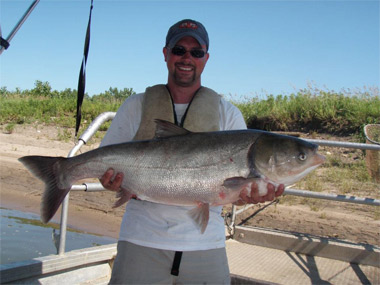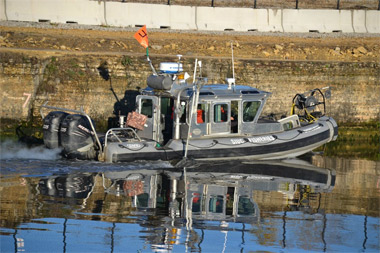
Big catch -- Dave Glover, a post-doctorate fellow at Southern Illinois University Carbondale’s Fisheries and Illinois Aquaculture Center, holds a silver carp from the Illinois River caught during sampling in summer 2011. SIU Carbondale has led the effort that for the last 18 months sought to quantify and solve the Asian carp problem in the state’s rivers. The team recently release a report titled ‘Fishing Down the Bighead and Silver Carps: Reducing the Risk of Invasion to the Great Lakes.’ (Photo provided) Download Photo Here
April 20, 2012
Study details Illinois’ Asian carp issue, solutions
CARBONDALE, ILL. -- Asian carp, that large, invasive fish known for leaping out of a river into boats when startled, now make up more than 60 percent of the total fish biomass in one of Illinois’ major river systems, a research team led by Southern Illinois University Carbondale has found.
But the team members’ advice for controlling the species goes something like this: “If you can’t beat ‘em, eat ‘em.”
James Garvey, director of the Fisheries and Illinois Aquaculture Center at SIU Carbondale, has led the effort that for the last 18 months to quantify and solve the Asian carp problem in the state’s rivers. In 2010, the University received a contract worth $1.1 million to find ways to eradicate the fish through commercial fishing and other means.
The grant from the Illinois Department of Natural Resources funded multiple studies and resulted in a report released last week titled “Fishing Down the Bighead and Silver Carps:
Reducing the Risk of Invasion to the Great Lakes.”
The report includes several major findings and strategies. Along with establishing that the carp now make up the majority of living tissue in the main channel of the Illinois River, it also found that eating the tasty, healthy, high-protein fish is plausible approach to greatly reducing its numbers.
“We basically found that harvesting this fish for commercial purposes will work, and that there is a market among consumers for this fish,” Garvey said. “There are other challenges, such as processing the fish, but we believe it can be done.”
The research represents the most comprehensive estimate of a main-channel fish assemblage in history using research-grade, down-looking hydroacoustics coupled with other sampling techniques, Garvey said. The study also looked at mortality and reproductive potential, as well as the quality of the meat and potential commercial market for the fish.
“To date, fishing is the only feasible and effective control mechanism in the Illinois River,” the report states. “We conducted research to determine how marketing plus incentives might help facilitate fishing as an effective way to reduce Asian carp while enhancing sustainable harvest of native fishes.”
Asian carp, a large, bony fish, are present in the upper and lower portions of the Mississippi River, the lower Missouri River, the Illinois River and Ohio River. Several varieties -- including the bighead and the silver, which can grow to 100 pounds and leap into the air -- are present in Illinois waterways.
Populations of these fishes are growing dense in the lower and middle Illinois
River and both species are approaching the Chicago Area Waterway System (CAWS) and the defensive electrical barrier set up there to stop it. The team believes the downriver source populations of the fish will continue to send individuals upstream to challenge the CAWS and ultimately the Great Lakes until their numbers are reduced.
During the last decade, the state has taken action to prevent the fish from becoming prevalent in the Great Lakes fisheries. To that end, Garvey said, many government agencies are dedicating resources to studying and fixing the problem.
Although the major concern regarding the carps’ entry into Illinois waterways and the Great Lakes is the fear that it will hurt the populations of native fish, Garvey said their team found -- at least so far -- that isn’t true.
“We’ve seen no extinctions of native species, although numbers of some important commercial species, such as big mouth buffalo fish and food source fish such as the gizzard shad, have declined,” Garvey said.
To conduct the study, researchers spent weeks aboard The Shovelnose, the University’s 27-foot research vessel outfitted with sophisticated equipment. Two or three crewmembers piloted the boat up and down the Illinois and Mississippi rivers, traveling more than 2,100 miles while conducting hydro-acoustic surveys and catching, tagging and releasing carp for tracking.
The hydro-acoustic surveys revealed that about 2,800 Asian carp live in each mile. Tagging the fish also showed the larger fish moved hundreds of miles up and down the river, though the researchers aren’t yet sure why.
“As is always the case with science, you often have more questions than answers,” Garvey said. “We saw a large movement corresponding with the floods last year, which was fascinating. But we don’t what exactly triggered them to do that. And we don’t know if they are moving somewhere to spawn. We need to do more research.”
Along with Garvey, SIU Carbondale researchers on the project include: Jesse Trushenski, assistant professor of zoology and also animal science, food and nutrition; Greg Whitledge, associate professor of zoology; Brian C. Small, associate professor of animal science, food and nutrition; Silvia Secchi, assistant professor of agribusiness economics; David Glover, a post-doctorate fellow with the Fisheries and Illinois Aquaculture Center; and Sara J. Trip, a former researcher with the Fisheries and Illinois Aquaculture Center.
Secchi’s work focused on the problem from an ecologically economic point of view. Secchi looked at the potential of different strategies for turning the Asian carp biomass into something valuable such as food source for humans or fishmeal for supplementing fish feed or fertilizers.
The fish is high in protein and healthy polyunsaturated fatty acids. Most fish also were low in contaminates. It has a mild flavor and is among one of the healthier fish for consumption, given its plankton feeding habits. In China, where the head of the big head variety is used to make soup, the fish has been hunted to near eradication.
Secchi’s research showed that a market exists for Asian carp, although the infrastructure in the region for capturing, processing, and transporting the fish is poorly developed. China currently is importing whole, flash-frozen Asian carp, but demand appears to depend on exporting large-bodied fish in large quantities, with an apparent premium on bighead carp.
The team also sees an opportunity in converting Asian carp into fishmeal, although additional infrastructure is needed for an appropriate processing facility. In addition to exporting the fish for human consumption and making it into fishmeal, marketing research suggested that U.S. consumers across a wide range of demographics are willing to try Asian carp and would be interested in purchasing a value-added product such as fish cakes, particularly if marketed as locally produced, the report stated. Again, however, the primary hurdle for developing such products is a lack of infrastructure in the region, not public perception.
Garvey said even with a concerted effort to commercially remove the fish from Illinois waterways, it is likely it would remain there in substantial numbers. Such an outcome, however, might be beneficial in that it would sustain a new industry based on the fish’s harvest.
Along with SIU Carbondale, researchers from Illinois Natural History Survey, the University of Illinois and Michigan State University collaborated on the project.
The executive summary of the report can be found here: http://asiancarp.us/documents/EXECCARP2011.pdf

Research vessel -- The research vessel Shovelnose speeds along the
Illinois River near the anti-fish electric barrier in Chicago with Southern Illinois
University Carbondale zoology graduate student Aaron Kern in command.
The vessel, which belongs to the University’s Fisheries and Illinois Aquaculture
Center, traversed more 2,100 miles while conducting hydro-acoustic surveys
and fish-tagging in an effort to quantify and solve the Asian carp problem
in the state’s rivers. The research team, let by SIU Carbondale, recently
released a report titled ‘Fishing Down the Bighead and Silver Carps: Reducing
the Risk of Invasion to the Great Lakes.’ (Photo provided) Download Photo Here
